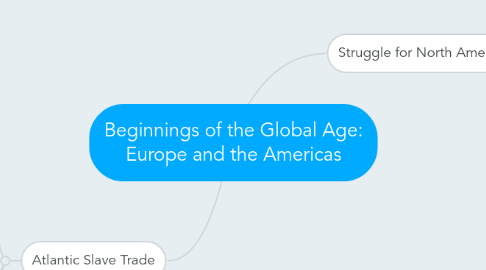
1. Atlantic Slave Trade
1.1. Triangular trade.
1.1.1. Linked Europe, the Americas, and Africa.
1.1.2. Europeans brought valuables to Africa to trade for slaves.
1.1.3. Many slaved died on the Middle Passage (trans-Atlantic trip to America).
1.1.3.1. Hundreds of Africans were crammed below decks and susceptible to disease and malnutrition.
1.1.4. On the final leg of the trip, merchants brought sugar, cotton, and other goods to Europe.
1.2. The Atlantic Slave Trade brought great wealth to Europe and greatly boosted colonial economic growth.
1.3. An estimated 11 million enslaved Africans reached the Americas.
2. Struggle for North America
2.1. English Colonies
2.1.1. First permanent colony at Jamestown, Virginia, in 1607.
2.1.1.1. Many died but with the help of the Native Americans, they grew tobacco.
2.1.2. 1620, the Mayflower with Protestants landed at Plymouth, Massachusetts.
2.1.2.1. Local Native Americans taught the colonists how to grow corn.
2.1.3. Through the 1600s and 1700s, the English continue to establish colonies.
2.1.4. They abandoned the Spanish dreams of finding riches.
2.1.5. English monarchs ruled the colonies and appointed oversea governors.
2.2. New France
2.2.1. Early 1500s, French missionaries and explorers start to claim land in Canada.
2.2.2. Fur traders, trappers, and fishers moved inland with the assistance of the Native Americans.
2.2.3. King Louis XIV (1600s) sent nobles to New France to facilitate economic growth.
2.2.3.1. 1700s, French forts and missions stretch from Quebec to Louisiana.
2.3. By the 1600s, Spain, France, England, and the Netherlands all had competing colonies.
2.3.1. The British and French engaged in the French and Indian War.
2.3.2. 1763, The Treaty of Paris ended the wars and established British dominance.
